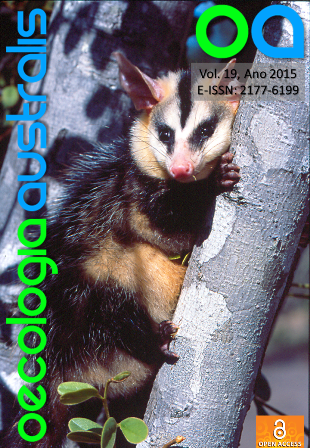NATURAL HISTORY OF THE WATER OPOSSUM CHIRONECTES MINIMUS: A REVIEW
DOI:
https://doi.org/10.4257/oeco.2015.1901.04Keywords:
activity patterns, demography, habitat selection, resting sites, spatial patternsAbstract
We reviewed information about the natural history of the water opossum Chironectes minimus and brought new data on a population studied in Atlantic Forest streams of Rio de Janeiro State, Brazil. The study was carried out from October 2004 to February 2011 using capture-mark-recapture and radiotelemetry techniques. We obtained 127 captures of 43 individuals, and 439 nocturnal locations of 13 individuals. Between July 2006 and October 2007 the population density varied between 0.11 e 0.73 ind./km of river. The overall sex ratio of captured individuals was biased towards males by 3.5:1. Adult males had a mean weight 24% greater than adult females. Young individuals were captured throughout the year, except in August, September and November. Water opossum presented a unimodal activity pattern, with activity increasing after sunset and decreasing thereafter along the night. Their activity patterns were influenced by sex and season. Home lengths varied from 870 to 5,860 m. We observed a high home length overlap between individuals, except among females. Water opossum abundance was higher in wide rivers with high tree density in the riverbank. Their resting sites were placed in river banks with well preserved and forested vegetation, evenly located in rocky substrate, in root systems within terricolous soil or in a mixture of the three different types of substrate (i.e. rocks, roots and soil). Although water opossum is a semi-aquatic species, it presents a lot of similarities with the terrestrial opossums, like sexual dimorphism, poliginic/promiscuous mating system, and nocturnal habits. Like other opossums, habitat loss and transformation are major issues for the conservation of this species.
Downloads
Downloads
Additional Files
- camiladebarros, Cover letter.doc (Português (Brasil))
- camiladebarros, Fig.1.jpg (Português (Brasil))
- camiladebarros, Fig.2.jpg (Português (Brasil))
- camiladebarros, Fig.3.jpg (Português (Brasil))
- camiladebarros, Fig.4.jpg (Português (Brasil))
- camiladebarros, Fig.5.jpg (Português (Brasil))
- camiladebarros, 958-6216-1-ED mod Nat.doc (Português (Brasil))
- camiladebarros, 958-6009-1-RV Reviewer C mod Nat.docx (Português (Brasil))


